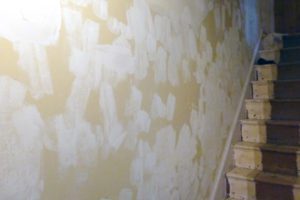 These days there are a large range of filling materials available for making good to interior surfaces. Be sure you use the right the product for the right job as not doing so can lead to more work for you in the future!
These days there are a large range of filling materials available for making good to interior surfaces. Be sure you use the right the product for the right job as not doing so can lead to more work for you in the future!
I am going to list the four main types that you as the general public are likely to use, putting them into groups. The more specialised filling products that a professional like I would use will not be covered, as I do not expect the general public to ever require them.
I will break them down over this month and next as it is a long piece.
Power filler
This comes as a fine white powder that you add cold water to and it mixes into a smooth creamy paste that will set after about one hour but will need to be dry before you can rub it down or paint over. A lot of companies make it, the better known brands being Polyfilla and Tetrion but all the major DIY stores do their home brands. This is a plaster-based filler, being the cheaper version of plaster of Paris, which was used in the old days?
As it is a plaster-based filler it is ideal for making good to cracks, holes and other defects to interior plaster i.e. walls and ceilings. Can fill quite large areas if built up in layers but can work out quite expense due to the amount used. Use proper gypsum plaster for very large areas. It is relatively easy to rub down (although some are harder than others) as generally it is a relatively soft filler when set. When set, it is not flexible and will re-crack if the surface moves, so should not be used around door frames, window frames and skirting boards where flexibility is required.
Also it is not hard enough to drill or to take nails/screws or for filling holes to woodwork, even though the box will say so! Although it is called a multi purpose filler for all types of making good, it is really only for making good to plaster because of its soft nature. This can only been used inside.
Ready mixed filler
The DIYer’s favourite. This comes in a plastic tub ready mixed for immediate use, and has a slightly course texture. Most often comes in white but sometimes also in a buff colour.
Again the label will say multi purpose filler but I would never use this filler on plasterwork as it sets rock hard and is impossible to rub down without destroying the surrounding plaster! Believe me I know, the times I have had to try and rub this stuff down after the husband has helpfully filled the walls for me! Will drill and take screws when set. This filler is best used for making good to woodwork or nail and screw holes in woodwork as for this you will need a hard filler that will not crumble over time as powder fillers do. Also the timber is hard enough to take the heavy rubbing down required to flatten this filler.
Remember as this is a water based filler, bare nails and screw heads that are not galvanized will need to be spot primed first with a metal primer or the filler will make them rust. Also the when it comes to rubbing this filler down you are going to have to use Aluminium Oxide paper (you know the stuff that comes in a roll and is sold by the metre) this is the only sand paper that will flatten it, the old fashion sandpaper and glass paper will hardly touch it. This can be used inside and outside.

